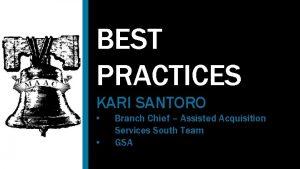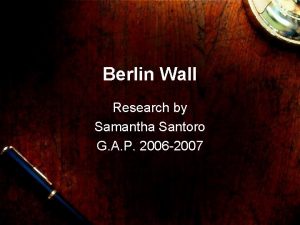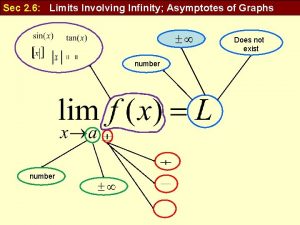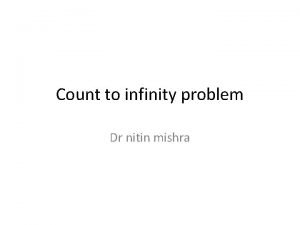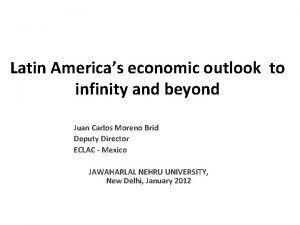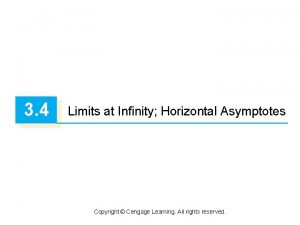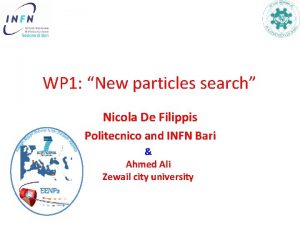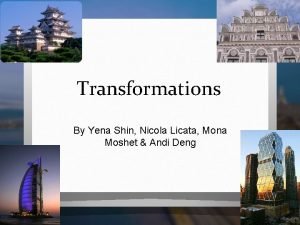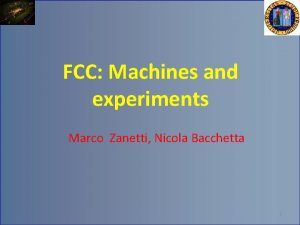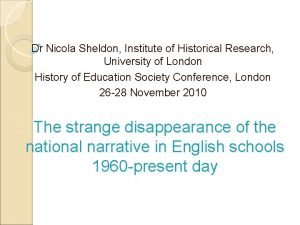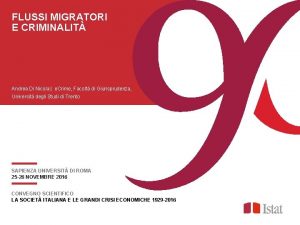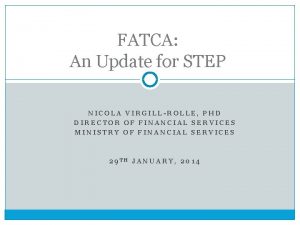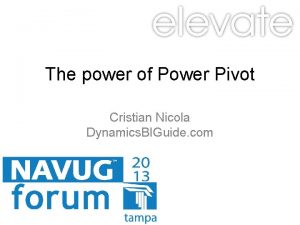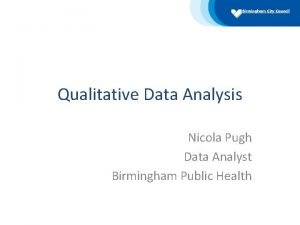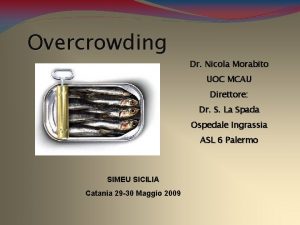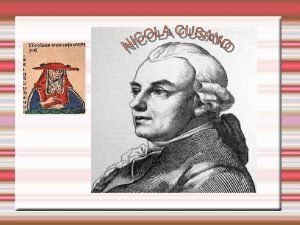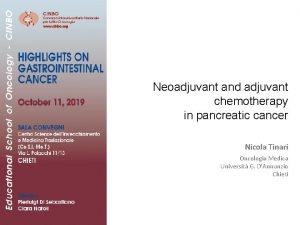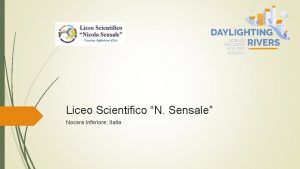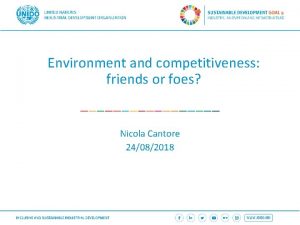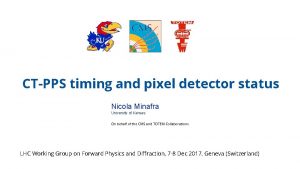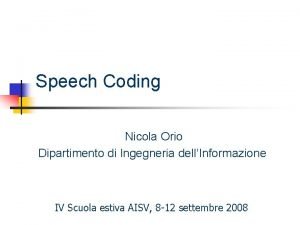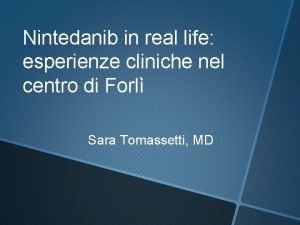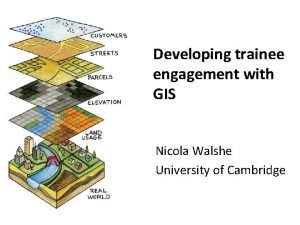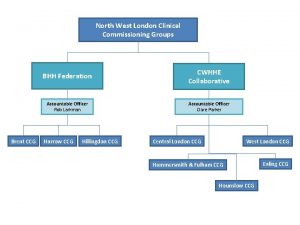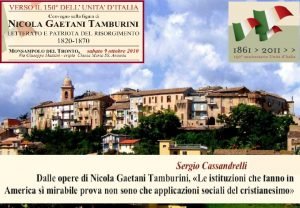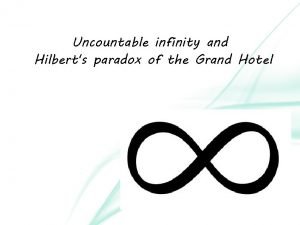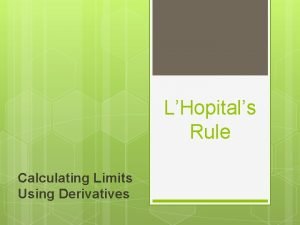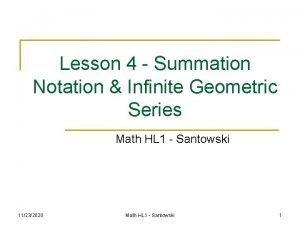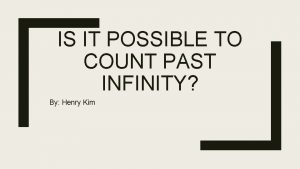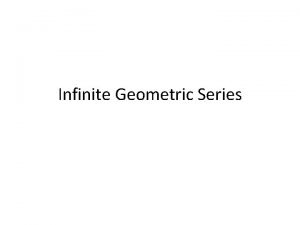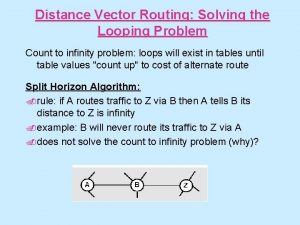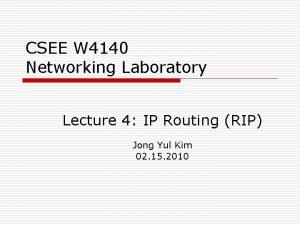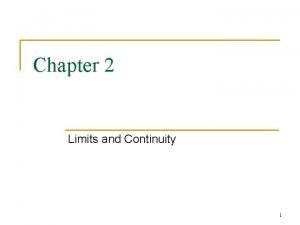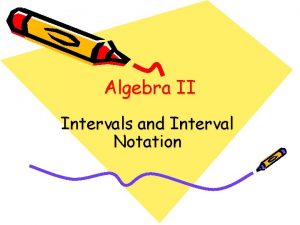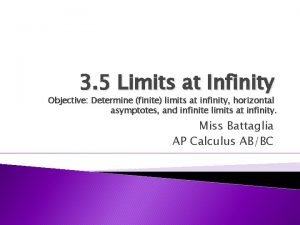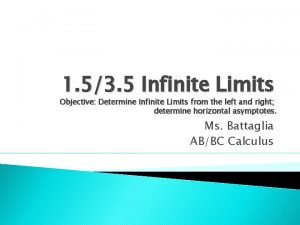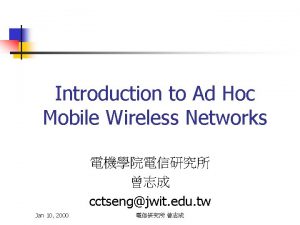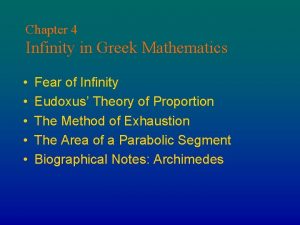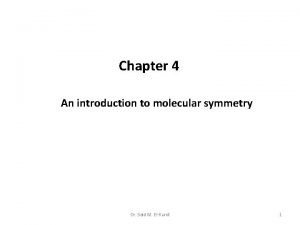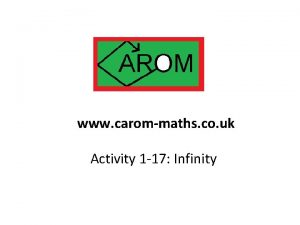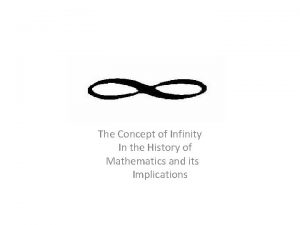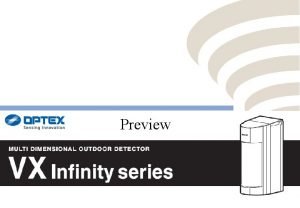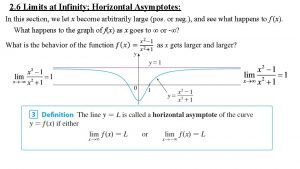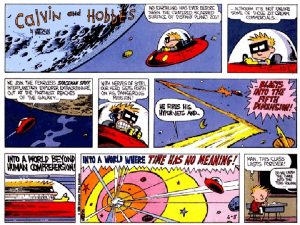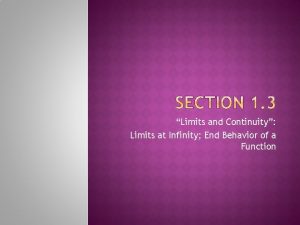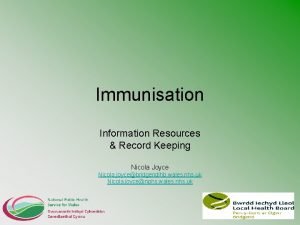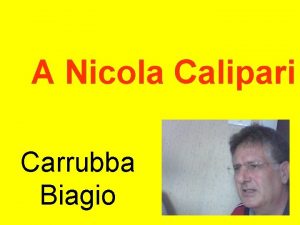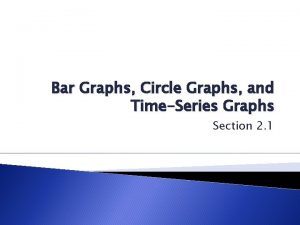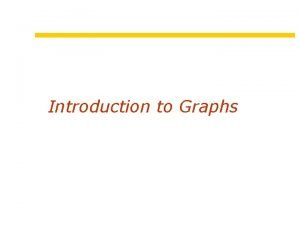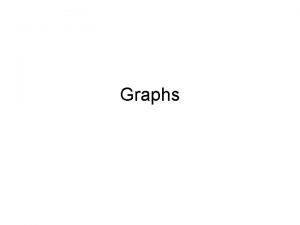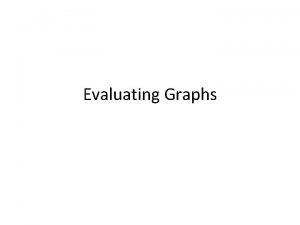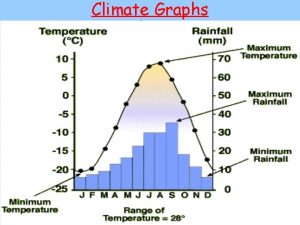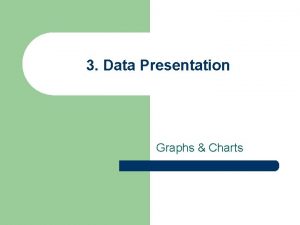On Infinity Continuity and TimeVarying Graphs Nicola Santoro























































![TVG SYSTEMS CLASSES PROBLEMS computational power G[recurrent P[recurrent] ] B-bounded recurrent G[bounded] P-periodic G[periodic] TVG SYSTEMS CLASSES PROBLEMS computational power G[recurrent P[recurrent] ] B-bounded recurrent G[bounded] P-periodic G[periodic]](https://slidetodoc.com/presentation_image_h/20f0eb14b4e952b4479cc35f50d28925/image-56.jpg)
![TVG SYSTEMS PROBLEMS Foremost. Bcast ≺ Shortest. Bcast ≺ Fastest. Bcast BROADCAST recurrent P[recurrent] TVG SYSTEMS PROBLEMS Foremost. Bcast ≺ Shortest. Bcast ≺ Fastest. Bcast BROADCAST recurrent P[recurrent]](https://slidetodoc.com/presentation_image_h/20f0eb14b4e952b4479cc35f50d28925/image-57.jpg)

![TVG Foremost. Bcast ≺ Shortest. Bcast ≺ Fastest. Bcast P[periodic] periodic Í/ P[bounded] Í/ TVG Foremost. Bcast ≺ Shortest. Bcast ≺ Fastest. Bcast P[periodic] periodic Í/ P[bounded] Í/](https://slidetodoc.com/presentation_image_h/20f0eb14b4e952b4479cc35f50d28925/image-59.jpg)




















![TVG waiting A mobile agent E [1, 3) Traverse path [A, E, D] t=0 TVG waiting A mobile agent E [1, 3) Traverse path [A, E, D] t=0](https://slidetodoc.com/presentation_image_h/20f0eb14b4e952b4479cc35f50d28925/image-80.jpg)
![TVG waiting A E [1, 3) Traverse path [A, E, D] t=1 WAIT at TVG waiting A E [1, 3) Traverse path [A, E, D] t=1 WAIT at](https://slidetodoc.com/presentation_image_h/20f0eb14b4e952b4479cc35f50d28925/image-81.jpg)
![Time-Varying Graph: waiting A E [1, 3) Traverse path [A, E, D] t=2 t=3 Time-Varying Graph: waiting A E [1, 3) Traverse path [A, E, D] t=2 t=3](https://slidetodoc.com/presentation_image_h/20f0eb14b4e952b4479cc35f50d28925/image-82.jpg)






















- Slides: 104

On Infinity, Continuity and Time-Varying Graphs Nicola Santoro Carleton University Nicola Santoro - Patras 2019 !!!

Distributed Computing Network of computational entities communicating by message transmission Information Diffusion, Agreement, Distributed Data, … Nicola Santoro - Patras 2019

Distributed Computing System of mobile computational entities operating in a network Search, Exploration, Monitoring, Gathering, … Nicola Santoro - Patras 2019

Distributed Computing Network of computational entities communicating by message transmission System of mobile computational entities operating in a network Nicola Santoro - Patras 2019

Dynamic Networks - Dynamic Graphs topology is subject to changes - Faults and Failures Link/Node deletion ===> disactivation Link/Node addition ===> (re)activation -- small scale phenomena (few, localized) -- fault-tolerance Nicola Santoro - Patras 2019

Dynamic Networks topology is subject to extensive changes Self Stabilization instability Nicola Santoro - Patras 2019 instability

Dynamic Networks Changes are continuous , possibly extensive , and never stop instability Nicola Santoro - Patras 2019

Dynamic Networks Changes are continuous , possibly extensive , and never stop Changes are not anomalies but rather integral part of the nature of the system. instability Nicola Santoro - Patras 2019

Dynamic Networks : WIRELESS MOBILE mobile ad hoc networks - topology may change dramatically over time due to the movement of the nodes vehicular networks - topology changes continuously as vehicles move Nicola Santoro - Patras 2019

Dynamic Networks : WIRELESS MOBILE Nicola Santoro - Patras 2019

Dynamic Networks : WIRELESS MOBILE half communication range Nicola Santoro - Patras 2019

Dynamic Networks : WIRELESS MOBILE Communication Graph Nicola Santoro - Patras 2019

Dynamic Networks : WIRELESS MOBILE Communication Graph Nicola Santoro - Patras 2019

Dynamic Networks : WIRELESS MOBILE Nicola Santoro - Patras 2019

Dynamic Networks : TEMPORALLY CONNECTED end-to-end connectivity does not necessarily hold the network might be always disconnected still … communication may be available over time and space, making computations feasible Nicola Santoro - Patras 2019

Dynamic Networks : Public Transports with fixed timetable Monitoring/Guarding tours PERIODIC Moving entities creating the network are periodic Low-earth orbiting satellite (LEO) systems NYC Santoro transit -(MTA) Nicola Patras 2019

Dynamic Networks : PEER-TO-PEER OVERLAY networks Nicola Santoro - Patras 2019

Dynamic Networks : SOCIAL NETWORKS/WEB GRAPHS FACEBOOK Nicola Santoro - Patras 2019

Dynamic Networks : SOCIAL NETWORKS/WEB GRAPHS LINKEDIN SANTORO Nicola Santoro - Patras 2019

Dynamic Networks Live System lifetime of system Unlimited (infinite) Computing in live systems unknown beginning Nicola Santoro - Patras 2019

Dynamic Networks Dead System lifetime of system Finite Post-mortem analysis known beginning end Collected (eg Social) Network Data need to be analyzed to understand patterns structures Nicola Santoro - Patras 2019

Dynamic Networks G Live System Infinite compute Dead System Finite On-Line Off-line Decentralized Centralized The computation takes place in the evolving system compute The finite system data is the input of the computation Nicola Santoro - Patras 2019

Dynamic Networks Formalism to describe/represent dynamic networks and their evolution for (post-mortem or live) analysis graphs natural means to represent and analyze static networks time-varying graphs natural means to represent and analyze dynamic networks Nicola Santoro - Patras 2019

TVG A general mathematical formalism that describes many different types of dynamic networks Includes existing formalisms as special cases Allows representation and analysis of live systems without restrictive assumptions Casteigts, Flocchini, Quattrociocchi, Santoro. Time-varying graphs and dynamic networks. IJPEDS, 2012. Nicola Santoro - Patras 2019

TVG G = (N, E, T, ψ, ρ, ζ ) Nicola Santoro - Patras 2019

TVG G = (N, E, T, ψ, ρ, ζ ) TVG-entities (nodes, vehicles, sensors, web sites, … ) Nicola Santoro - Patras 2019

TVG G = (N, E, T, ψ, ρ, ζ ) E⊆N×N connections between pairs of TVG-entities (edges, links, interactions, contacts … ) Nicola Santoro - Patras 2019

TVG G = (N, E, T, ψ, ρ, ζ ) E⊆N×N(×L) connections between pairs of TVG-entities (edges, links, interactions, contacts … ) with (domain- specific multi-valued) labels e. g. <satellite; bandwidth 4 MHz; encryption available; . . . > Nicola Santoro - Patras 2019

TVG G = (N, E, T, ψ, ρ, ζ ) lifetime of system R Limited (finite) Nicola Santoro - Patras 2019

TVG G = (N, E, T, ψ, ρ, ζ ) lifetime of system Unlimited (infinite) Nicola Santoro - Patras 2019

TVG G = (N, E, T, ψ, ρ, ζ ) lifetime of system 0 Unlimited (infinite) beginning Nicola Santoro - Patras 2019

TVG G = (N, E, T, ψ, ρ, ζ ) node presence function ψ : N × T → {0, 1} edge presence function ρ : E × T → {0, 1} ψ(x, t)=1 iff x is in present at time t ρ(e, t)=1 iff e is present at time t Nicola Santoro - Patras 2019

TVG G = (N, E, T, ψ, ρ, ζ ) ζ: E×T→T ˛Ç latency function {^} ζ((x, y), t) = d message from x to y, if sent at time t, will arrive at time t+d traversal from x to y, if started at time t, ends at time t+d Nicola Santoro - Patras 2019

TVG G = (N, E, T, ψ, ρ, ζ ) ζ: E×T→T ˛Ç latency function {^} ζ((x, y), t) = ^ message from x to y, if sent at time t, will not arrive traversal from x to y, if started at time t, cannot be done Nicola Santoro - Patras 2019

TVG G = (N, E, T, ψ, ρ, ζ ) Nicola Santoro - Patras 2019

TVG G = (N, E, T, ψ, ρ, ζ ) G(t) = (N(t) , E(t)) SNAPSHOT at time t ∈ T N(t) = { x ∈ N : ψ(x, t)=1 } E(t) = { e ∈ E : ρ(e, t)=1 } G = (N , E) FOOTPRINT Nicola Santoro - Patras 2019

TVG journey G = (N, E, T, ψ, ρ, ζ ) JOURNEY “walk over time” < (e 1 , t 1 ), (e 2 , t 2 ), . . . , (ek , tk ) , (ek+1 , tk+1 ), . . . > - <e 1 , e 2 , . . . , ek+1 , . . . > is a walk in G - ∀i, ρ(ei , ti) = 1 AND ti+1 ≥ ti + ζ (ei , ti) Nicola Santoro - Patras 2019

TVG journey ``distance” from node x to node y at time t topological measure: minimum length among all the journeys from x to y starting at or after time t shortest journey temporal measure: minimum duration among all the journeys from x to y starting at or after time t fastest journey temporal measure: earliest arrival among all the journeys from x to y starting at or after time t foremost journey Nicola Santoro - Patras 2019

journey TVG E C 9: 30 D 12: 10 19: 15 H G 9: 00 22: 15 22: 00 A 9: 00 shortest F 18: 00 A, I, B I B 20: 30 min # hops (2 hops) earliest arrival (19: 15) foremost A, C, D, E, F fastest A, G, H, BNicola. Santoro smallest duration - Patras 2019 (15 minutes)

TVG Live System Unlimited known 0 unknown t past present Nicola Santoro - Patras 2019 future

TVG Dead System Finite study the past Discrete - emergence of special structures forecast the future known 0 t past present Nicola Santoro - Patras 2019 future

TVG Live System Infinite Computing in live systems unknown 0 t past present Nicola Santoro - Patras 2019 future

TVG Computing in dynamic systems unknown present Nicola Santoro - Patras 2019

TVG Computing in dynamic systems ASSUMPTIONS a-priori knowledge oracle something must be known present Nicola Santoro - Patras 2019

TVG BASIC ASSUMPTIONS The number of nodes (thus, the footprint) is finite Number of events in any limited interval of time is finite not enough ! 0 Nicola Santoro - Patras 2019

TVG EDGE x y transient $ t ∀t’>t : ψ ((x, y), t’) = 0 recurrent ∀t $ t’>t : ψ ((x, y), t’) = 1 LOCAL FAIRNESS (e. g. , Population Protocols) Nicola Santoro - Patras 2019

TVG EDGE ? x y transient undecidable recurrent Nicola Santoro - Patras 2019

TVG If N is finite from a certain time on there will be only recurrent edges undecidable 0 transient & recurrent ? t Nicola Santoro - Patras 2019 only recurrent

TVG EDGE x y recurrent bounded recurrent $ B (∀t ψ((x, y), t)=1 ($ t’, t <t’ £ t+B, (ψ((x, y), t’)=1))) periodic $ P (∀t ψ((x, y), t)=1 ( ψ((x, y), t’) = 1)) Nicola Santoro - Patras 2019

TVG EDGE x periodic ? undecidable Nicola Santoro - Patras 2019 y

TVG EDGE x periodic y P knowledge unknown upperbound Nicola Santoro - Patras 2019

TVG EDGE x periodic y P knowledge unknown upperbound “ Is period = P ? ‘’ undecidable Nicola Santoro - Patras 2019

TVG EDGE x periodic y P knowledge unknown upperbound Nicola Santoro - Patras 2019 P-periodic

TVG EDGE x y recurrent B-bounded recurrent P-periodic Nicola Santoro - Patras 2019

TVG Common Assumptions SYSTEM G recurrent all edges are recurrent B-bounded recurrent all edges are B-bounded recurrent P-periodic all edges are P-periodic Nicola Santoro - Patras 2019
![TVG SYSTEMS CLASSES PROBLEMS computational power Grecurrent Precurrent Bbounded recurrent Gbounded Pperiodic Gperiodic TVG SYSTEMS CLASSES PROBLEMS computational power G[recurrent P[recurrent] ] B-bounded recurrent G[bounded] P-periodic G[periodic]](https://slidetodoc.com/presentation_image_h/20f0eb14b4e952b4479cc35f50d28925/image-56.jpg)
TVG SYSTEMS CLASSES PROBLEMS computational power G[recurrent P[recurrent] ] B-bounded recurrent G[bounded] P-periodic G[periodic] P[periodic] Nicola Santoro - Patras 2019
![TVG SYSTEMS PROBLEMS Foremost Bcast Shortest Bcast Fastest Bcast BROADCAST recurrent Precurrent TVG SYSTEMS PROBLEMS Foremost. Bcast ≺ Shortest. Bcast ≺ Fastest. Bcast BROADCAST recurrent P[recurrent]](https://slidetodoc.com/presentation_image_h/20f0eb14b4e952b4479cc35f50d28925/image-57.jpg)
TVG SYSTEMS PROBLEMS Foremost. Bcast ≺ Shortest. Bcast ≺ Fastest. Bcast BROADCAST recurrent P[recurrent] B-bounded recurrent P[bounded] P-periodic P[periodic] Nicola Santoro - Patras 2019

TVG SYSTEMS PROBLEMS Foremost. Bcast ≺ Shortest. Bcast ≺ Fastest. Bcast foremost broadcast Î recurrent shortest broadcast Ï B-bounded recurrent P-periodic BROADCAST shortest broadcast Î P[recurrent] fastest broadcast Ï P[bounded] fastest broadcast Î P[periodic] Nicola Santoro - Patras 2019
![TVG Foremost Bcast Shortest Bcast Fastest Bcast Pperiodic periodic Í Pbounded Í TVG Foremost. Bcast ≺ Shortest. Bcast ≺ Fastest. Bcast P[periodic] periodic Í/ P[bounded] Í/](https://slidetodoc.com/presentation_image_h/20f0eb14b4e952b4479cc35f50d28925/image-59.jpg)
TVG Foremost. Bcast ≺ Shortest. Bcast ≺ Fastest. Bcast P[periodic] periodic Í/ P[bounded] Í/ P[recurrent] ‹ bounded ‹ recurrent PROBLEMS SYSTEMS A. Casteigts, P. Flocchini, B. Mans, N. Santoro. Measuring temporal lags in delaytolerant networks. IEEE Trans. on Computers, 2014 A. Casteigts, P. Flocchini, B. Mans, N. Santoro. Shortest, fastest, and foremost broadcast in dynamic networks. J. Found. Comp. Nicola. Int. Santoro - Patras 2019 Sci, 2015

TVG Common Assumption DISCRETE most common assumption

Common Assumption TVG DISCRETE G = (N, E, T, ψ, ρ, ζ ) synchronous discrete rounds Z+ 0 1 2 3 . .

Common Assumption TVG DISCRETE many equivalent formulations G = (N, E, T, ψ, ρ, ζ ) C⊆N×N×T×T T = (N, C) edge contacts start end TEMPORAL NETWORK interval P. Holme , J. Saramäki. “Temporal networks”. Physics Reports, 2012. Nicola Santoro - Patras 2019

Common Assumption TVG DISCRETE many equivalent formulations G = (N, E, T, ψ, ρ, ζ ) SNAPSHOTS sequence of SNAPSHOTS 0 1 2 Nicola Santoro - Patras 2019 3 …

Common Assumption TVG DISCRETE many equivalent formulations G = (N, E, T, ψ, ρ, ζ ) G(0), G(1), G(2), G(3) sequence of SNAPSHOTS 0 1 2 Nicola Santoro - Patras 2019 3

TVG Common Assumption DISCRETE many equivalent formulations G = (N, E, T, ψ, ρ, ζ ) G(0), G(1), G(2), G(3), … sequence of GRAPHS EVOLVING GRAPH F. Harary and G. Gupta. “Dynamic graph models”. Mathematical and Computer Modelling, 1997. A. Ferreira. “On models and algorithms for communication in dynamic networks”. ALGOTEL, 2002. Nicola Santoro - Patras 2019

Common Assumption TVG DISCRETE many equivalent formulations Time-Varying Graphs Nicosia, Tang, Musolesi, Russo, Mascolo, Latora. Components in time-varying graphs. Chaos 2012 Temporal Graphs O. Michail , P. G. Spirakis. Traveling salesman problems in temporal graphs. MFC, 2014 Temporal Networks R. Pan, J. Sarama ki. Path lengths, correlations, and centrality in temporal networks. Phys. Rev. E, 2011 Nicola Santoro - Patras 2019

Common Assumption TVG DISCRETE 0 many equivalent formulations 1 2 Nicola Santoro - Patras 2019 3

Common Assumption TVG 0 1 2 3 Nicola Santoro - Patras 2019

Common Assumption TVG 0 1 layers 2 3 Nicola Santoro - Patras 2019

Common Assumption TVG 0 1 inter-layers connections 2 3 Nicola Santoro - Patras 2019

Common Assumption TVG DISCRETE many equivalent formulations 0 1 TIME VARYING GRAPH Basu et al. , Co. RR. 2010. MULTI-LAYER (MULTIPLEX) NETWORK 2 3 Krivela et al. “Multilayer networks”. J. Complex Networks, 2014. Boccaletti et al, “The structure and dynamics of multilayer networks” Pysics Rep. 2014 Nicola Santoro - Patras 2019

Common Assumptions TVG RECURRENT --BOUNDED RECURRENT ---PERIODIC DISCRETE no implications on CONNECTIVITY ALL G(t) COULD BE DISCONNECTED Nicola Santoro - Patras 2019

TVG TEMPORAL CONNECTIVITY Temporally Connected for all t, x, y $ Journey(x, y, t) weakest possible typical assumption in engineering community B. Awerbuch and S. Even. Efficient and reliable broadcast is achievable in an eventually connected network. 3 rd PODC, 1984. ALL G(t) COULD BE DISCONNECTED Nicola Santoro - Patras 2019

TVG PHYSICAL CONNECTIVITY Recurrently Connected ∀t $ t’ ≥ t : G(t’) is connected Periodically Connected ∀t $ t’ ≥ t : for all j G(t’+j p) is connected Always Connected ∀t, G(t) is connected Always Connected & T-Persistent Backbone ∀t, GT(t) = Çt=<t’=<t+T G(t’) Nicola Santoro - Patras 2019 is connected

TVG Connectivity Assumptions Always connectect Periodic Recurrent T-Persistent Always+Backbone Nicola Santoro - Patras 2019 Temporal

Connectivity + Discrete TVG Always connectect 1 -interval connectivity + Discrete T-Persistent Backbone + T-interval connectivity Discrete Nicola Santoro - Patras 2019

TVG - 1 -INTERVAL CONNECTIVITY R. O'Dell, R. Wattenhofer. Information dissemination in highly dynamic graphs. Workshop on Foundations of Mobile Computing, 2005. F. Kuhn, N. Lynch, R. Oshman. Distributed computation in dynamic networks. 42 nd ACM Symposium on Theory of Computing (STOC), 513– 522, 2010. F. Kuhn, Y. Moses, R. Oshman. Coordinated consensus in dynamic networks. 30 th Symposium on Principles of Distributed Computing (PODC), 2011. F. Kuhn, T. Locher, R. Oshman. Gradient clock synchronization in dynamic networks. Theory of Computing Systems, 2011. B. Haeupler, F. Kuhn. Lower bounds on information dissemination in dynamic networks. 26 th Int. Symposium on Distributed Computing (DISC), 2012. D. Ilcinkas, A. M. Wade. Exploration of the T-Interval-connected dynamic graphs: the case of the ring. SIROCCO, 2013. D. Ilcinkas, R. Klasing, A. M. Wade. Exploration of constantly connected dynamic graphs based on cactuses. SIROCCO, 2014. G. Sharma, C. Bush. Distributed queueing in dynamic networks. Parallel Processing Letters, 2015. Erlebach, M. Hoffmann, F. Kammer. On temporal graphs. 42 nd Int. Colloquium on Automata, Languages, and Programming (ICALP), 2015. G. Di Luna, S. Dobrev, P. Flocchini, N. Santoro. Live exploration of dynamic rings. Distributed Computing, 2018

TVG COMMON ASSUMPTIONS RECURRENT - BOUNDED RECURRENT -- PERIODIC DISCRETE TEMPORAL CONNECTIVITY - RECURRENT CONNECTIVITY -- PERIODIC CONNECTIVITY --- ALWAYS CONNECTED ---- T-BACKBONE CONNECTIVITY WAITING Nicola Santoro - Patras 2019

TVG JOURNEY waiting “walk over time” < (e 1 , t 1 ), (e 2 , t 2 ), . . . , (ek , tk ) , (ek+1 , tk+1 ), . . . > - <e 1 , e 2 , . . . , ek+1 , . . . > is a walk in G - ∀i, ρ(ei , ti) = 1 AND ti+1 ≥ ti + ζ (ei , ti) direct indirect ∀i ti+1 = ti + ζ (ei , ti) otherwise Nicola Santoro - Patras 2019
![TVG waiting A mobile agent E 1 3 Traverse path A E D t0 TVG waiting A mobile agent E [1, 3) Traverse path [A, E, D] t=0](https://slidetodoc.com/presentation_image_h/20f0eb14b4e952b4479cc35f50d28925/image-80.jpg)
TVG waiting A mobile agent E [1, 3) Traverse path [A, E, D] t=0 D E B [0, 2) B A C Nicola Santoro - Patras 2019 [2, 4) [0, 1) D [0, 1) [0, 3) [2, 4) C
![TVG waiting A E 1 3 Traverse path A E D t1 WAIT at TVG waiting A E [1, 3) Traverse path [A, E, D] t=1 WAIT at](https://slidetodoc.com/presentation_image_h/20f0eb14b4e952b4479cc35f50d28925/image-81.jpg)
TVG waiting A E [1, 3) Traverse path [A, E, D] t=1 WAIT at E D E B [0, 2) B A C Nicola Santoro - Patras 2019 [2, 4) [0, 1) D [0, 1) [0, 3) [2, 4) C
![TimeVarying Graph waiting A E 1 3 Traverse path A E D t2 t3 Time-Varying Graph: waiting A E [1, 3) Traverse path [A, E, D] t=2 t=3](https://slidetodoc.com/presentation_image_h/20f0eb14b4e952b4479cc35f50d28925/image-82.jpg)
Time-Varying Graph: waiting A E [1, 3) Traverse path [A, E, D] t=2 t=3 D E B [0, 2) B A C Nicola Santoro - Patras 2019 [2, 4) [0, 1) D [0, 1) [0, 3) [2, 4) C

TVG waiting A E [1, 3) Journey A, E, D [2, 4) [0, 1) [0, 2) B [0, 1) [0, 3) [2, 4) C Indirect: Waiting (buffering) Direct: No waiting (no buffering) Nicola Santoro - Patras 2019 D

TVG waiting A E [1, 3) Journey A, E, D [2, 4) [0, 1) [0, 2) B [0, 1) [0, 3) [2, 4) C Indirect: feasible Waiting (buffering) Direct: unfeasible No waiting (no buffering) Nicola Santoro - Patras 2019 D

TVG waiting A [2, 4) [0, 1) D E Journey C, B, A [1, 3) [0, 2) B [0, 1) [0, 3) [2, 4) C Indirect: feasible Waiting (buffering) Direct: feasible No waiting (no buffering) Nicola Santoro - Patras 2019

TVG waiting What difference does WAITING make ? Waiting (buffering) No waiting (no buffering) Nicola Santoro - Patras 2019

TVG waiting A [0, 1) [1, 3) E [2, 4) [0, 3) [0, 2) B D [0, 1) node labels -> alphabet symbols feasible journey -> word [2, 4) C alphabet Σ ={A, B, C, D, E} C B A FEASIBLE CBA A E D FEASIBLE if waiting AED Nicola Santoro - Patras 2019

TVG A A waiting [0, 1) [1, 3) E [0, 2) B [0, 1) D [2, 4) [0, 3) [2, 4) C node labels -> alphabet symbols feasible journey -> word feasible journeys from A to C -> language what type of LANGUAGE ? alphabet Σ ={A, B, C, D, E} Nicola Santoro - Patras 2019

TVG waiting feasible journeys from A to C -> language G FEASIBLE if waiting what type of LANGUAGES accepted by TVG automata?

TVG waiting Casteigts, Flocchini, Godard, Santoro, Yamashita. On the Expressivity of Time-Varying Graphs. Theoretical Computer Science, 2015 G what type of LANGUAGES accepted by TVG automata? If waiting IS NOT allowed TVG-automata accept ALL languages If waiting IS allowed TVG-automata accept only REGULAR languages

TVG COMMON ASSUMPTIONS RECURRENT - BOUNDED RECURRENT -- PERIODIC DISCRETE TEMPORAL CONNECTIVITY - RECURRENT CONNECTIVITY -- PERIODIC CONNECTIVITY --- ALWAYS CONNECTED ---- T-BACKBONE CONNECTIVITY WAITING Nicola Santoro - Patras 2019

TVG DISCRETE restrict … How restrictive is the assumption that the system is DISCRETE ? Live System Infinite study the past known 0 t past present Nicola Santoro - Patras 2019 future

TVG How restrictive is the assumption that the system is DISCRETE ? Post-mortem analysis beginning end Nicola Santoro - Patras 2019 Dead System Limited (finite)

TVG How restrictive is the assumption that the system is DISCRETE ? It is NOT restrictive at all THE NUMBER OF EVENTS THAT HAVE OCCURRED IS FINITE 1 2 3 4 5 6 7 8 9 10 end beginning Nicola Santoro - Patras 2019

TVG How restrictive is the assumption that the system is DISCRETE ? Live System Infinite Computing in dynamic systems 0 t past present Nicola Santoro - Patras 2019 future

TVG How restrictive is the assumption that the system is DISCRETE ? Live System Infinite It is very restrictive 0 t past present Nicola Santoro - Patras 2019 future

TVG How restrictive is the assumption that the system is DISCRETE ? Live System Infinite It is very restrictive i-1 i Nicola Santoro - Patras 2019

TVG How restrictive is the assumption that the system is DISCRETE ? Live System Infinite It is very restrictive Strong simplifying assumption allows algorithms to count and time-out i-1 i Nicola Santoro - Patras 2019

TVG How restrictive is the assumption that the system is DISCRETE ? It is very restrictive Strong simplifying assumption It limits the power of the Adversary Many live algorithms assume it FULLY SYNCHRONOUS Nicola Santoro - Patras 2019 Live System Infinite

TVG Remove/Weaken ASSUMPTIONS Live System DISCRETE & FULLY SYNCHRONOUS Infinite !!! DISCRETE & SEMI-SYNCHRONOUS) G. A. Di Luna, S. Dobrev, P. Flocchini, N. Santoro. Distributed exploration of dynamic rings. Distributed Computing, 2018. Nicola Santoro - Patras 2019

TVG Remove/Weaken ASSUMPTIONS Live System Develop live algorithms without DISCRETE assumption Infinite Continuous Nicola Santoro - Patras 2019

TVG Remove/Weaken ASSUMPTIONS Live System Develop live algorithms without DISCRETE assumption Infinite Continuous !!! SYNCHRONOUS A. Casteigts, P. Flocchini, B. Mans, N. Santoro. Measuring temporal lags in delaytolerant networks. IEEE Trans. on Computers, 2014 A. Casteigts, P. Flocchini, B. Mans, N. Santoro. Shortest, fastest, and foremost broadcast in dynamic networks. Int. J. Found. Comp. Sci, 2015 Nicola Santoro - Patras 2019

On Infinity, Continuity and Time-Varying Graphs Time to End Nicola Santoro - Patras 2019

Thank You Nicola Santoro - Patras 2019
 Fabrizio santoro
Fabrizio santoro Kari santoro
Kari santoro Samantha santoro
Samantha santoro Sec asymptotes
Sec asymptotes Absolute continuity implies uniform continuity
Absolute continuity implies uniform continuity State testing and testability tips
State testing and testability tips Graphs that enlighten and graphs that deceive
Graphs that enlighten and graphs that deceive Speed and velocity
Speed and velocity 5-3 practice polynomial functions
5-3 practice polynomial functions Steamboat willie apush
Steamboat willie apush Count to infinity problem solution
Count to infinity problem solution To infinity and beyond latin
To infinity and beyond latin Limits at infinity horizontal asymptotes
Limits at infinity horizontal asymptotes Limits involving infinity asymptotes
Limits involving infinity asymptotes Activity 3 to infinity and beyond
Activity 3 to infinity and beyond Nicola carozza
Nicola carozza Nicola licata
Nicola licata Nicola cezzi
Nicola cezzi Nicola allen knutsford
Nicola allen knutsford Angie verona nude
Angie verona nude Nicola yoon książki
Nicola yoon książki Nicola bacchetta
Nicola bacchetta Reiseberufe
Reiseberufe Nicola sheldon
Nicola sheldon Nicola cezzi
Nicola cezzi Nicola de bellis
Nicola de bellis Nicola tyas
Nicola tyas Recogniseble
Recogniseble Nicola niglio
Nicola niglio Nicola holt uwe
Nicola holt uwe Nicola riley
Nicola riley Nicola lugaresi
Nicola lugaresi Andrea di nicola
Andrea di nicola Sifat silvika kayu
Sifat silvika kayu Nicola cezzi
Nicola cezzi Nicola.szx
Nicola.szx Rocco de nicola
Rocco de nicola Summary of superhuman by nicola yoon
Summary of superhuman by nicola yoon Nicola aitchison
Nicola aitchison Nicola cezzi
Nicola cezzi Nicola kershaw
Nicola kershaw Flat coding frame
Flat coding frame Nicola morabito
Nicola morabito Nicola cezzi
Nicola cezzi Nicola cusano
Nicola cusano Nicola giovanni cezzi
Nicola giovanni cezzi Nicola cezzi
Nicola cezzi Nicola hogan
Nicola hogan Liceo scientifico nicola sensale nocera inferiore
Liceo scientifico nicola sensale nocera inferiore Nicola marchant
Nicola marchant Nicola cezzi
Nicola cezzi Phylosophy
Phylosophy Nicola cantore
Nicola cantore University of kansas
University of kansas Nicola bowman
Nicola bowman Nicola tyas sex
Nicola tyas sex Nicola benge
Nicola benge Casqe
Casqe Coding ingegneria
Coding ingegneria Nicola cigliano
Nicola cigliano Nicola cezzi
Nicola cezzi 52nd lpsc
52nd lpsc Nicola cezzi
Nicola cezzi Nicola cezzi
Nicola cezzi Nicola gale
Nicola gale Don nicola solla
Don nicola solla Brent clinical commissioning group
Brent clinical commissioning group Nicola cezzi
Nicola cezzi Nicola cezzi
Nicola cezzi Nicola cezzi
Nicola cezzi Nicola bowman
Nicola bowman Limits calculator
Limits calculator Hilbert's infinite hotel
Hilbert's infinite hotel G/4
G/4 When can we use l'hopital's rule
When can we use l'hopital's rule Sigma notation word problems
Sigma notation word problems Vsauce counting past infinity
Vsauce counting past infinity Infinity-data.xlsx
Infinity-data.xlsx Geometric series convergence
Geometric series convergence Count to infinity problem
Count to infinity problem Count to infinity problem
Count to infinity problem Limits at infinity definition
Limits at infinity definition Interval notation for infinity
Interval notation for infinity Limits at infinity definition
Limits at infinity definition How to determine infinite limits
How to determine infinite limits Complex gsm
Complex gsm Lens sign convention
Lens sign convention Tora
Tora Infinity in greek
Infinity in greek Trans cr(en)2f2 point group
Trans cr(en)2f2 point group Infinity next
Infinity next 1 to infinity
1 to infinity Infinity middle school calendar
Infinity middle school calendar Hris best practices
Hris best practices Check point infinity
Check point infinity Infinity symbol
Infinity symbol Infinite concept
Infinite concept Infinity vx
Infinity vx Infinite energy incorporated srl
Infinite energy incorporated srl Infinity media company
Infinity media company Sc421 - given product cannot be purchased infinity
Sc421 - given product cannot be purchased infinity Alteryx certification
Alteryx certification Limits at infinity horizontal asymptotes
Limits at infinity horizontal asymptotes Anthony infinity 090
Anthony infinity 090 Image formation by convex lens
Image formation by convex lens

